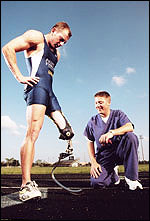
Scott Sabolich, CP, LP, spent three weeks at the Beijing Paralympics as the official prosthetist for Team USA. His facility, Scott Sabolich Prosthetics & Research, Oklahoma City, Oklahoma, built prostheses for one German, one Canadian, and seven American 2008 Paralympians-a cadre that scored a total of ten medals, including three gold and three world records. Sabolich’s almost unceasing work in China contributed not only to a remarkable medal count, but also to the participation of dozens of current-and future-Paralympians. Sabolich gave The O&P EDGE his insider’s story of the high-drama, high-pressure world of repairing and maintaining prostheses during the Paralympics.
The O&P EDGE:
How you were selected to be the official prosthetist for Team USA?
Sabolich:
There are maybe a handful of prosthetists who have a lot of experience in building running legs, and I’ve been involved in building Paralympic prosthetics since I was a technician back in 1996, working on Tony Volpentest’s legs for the Atlanta Paralympics. I built my first Paralympic prostheses from start to finish for Earle Connor shortly after those Games, and he competed in Sydney. I built probably 30 to 40 legs between Sydney and Greece. I’m sure that the selection process is also partly based on who would be willing to be gone for most of a month. It was an honor to be chosen.
The O&P EDGE:
You were gone for three weeks and knew that you’d have to work on quite a variety of problems. How did you prepare for the trip?
Sabolich:
(Laughs.) I started sleeping during the day and being awake during the night. Actually, we boxed up probably three or four crates worth of stuff-specialized running feet and other things that we might need. Otto Bock also had a very big supply of stuff to use, and they had a full fabrication facility set up.
The O&P EDGE:
What was a normal day like for you out in the field?
Sabolich:
When you have that many athletes at that many venues all the time, you’re working from about seven in the morning to 11 at night. And you’re trackside, tweaking, tuning, being there for support. Sometimes you’re just sitting doing nothing all day, waiting for something to break, and then when things do break, you’re busy, busy, busy.
The O&P EDGE:
When you look back on the trip, what moment most stands out in your memory?
Sabolich:
Well, I flew from Oklahoma City to Chicago, Chicago to Tokyo, Tokyo to Beijing-a day and a half to get there. I arrived at night, and then with 13 hours time difference, I had to go to sleep. I was woken up six hours later, and it was Marlon Shirley saying, “My leg needs to be completely rebuilt.” I’m like, “Um, you do realize that you we’re in China right? I’ve got limited stuff, and I didn’t bring enough stuff to build a complete leg. I brought parts.” With carbon fiber and casting, we were talking a two-week process, and he had to compete in three days. The back wall of his prosthesis was crushed in where the foot bolted to the frame, and when they tried to repair it in Tokyo during the training camp, they added too much weight. They had laminated over the top of the original lamination. He couldn’t run with it-it threw off his gait. So we had to basically clone the whole prosthesis right there in the Paralympic Village, in the Otto Bock tent. I was doing a lamination, which was bizarre. And then what was even more bizarre is that he said “Oh yeah, I can’t run on it ’til the event.” I’m like, “We can’t test it? We can’t even throw it on the track and see if the alignment’s right, or the height?” He’s like, “Nope, you’ve just gotta take your best shot at it and build it.” His ankle had just been shot up with cortisone, and the doctor said no running.
The O&P EDGE:
That sounds like one high-pressure project-how did it come out?
Sabolich:
After we spent a day and a half in the tent building it, Marlon’s prosthesis was about 1.9 pounds complete, race ready, and that’s what he was used to. When they had fixed it in Tokyo, it was like 3 or 3 1/2 pounds-way too heavy. I just kind of went by eye and feel and had him stand in it until I could say, “Okay, it’s ready to go to the competition.” He ran a semifinal in it, and he and Brian Frasure took first and second place. The prosthesis performed flawlessly, and the alignment looked awesome, so I was really stoked. If we hadn’t brought someone who really knew Marlon and really knew how to make a leg, start to finish, that could have cost a medal for the U.S.
The O&P EDGE:
As the official prosthetist, you weren’t just responsible to the individual athletes. You were also responsible to the team and to the people who are sending you over. What kind of pressure did that put on you?
Sabolich:
Not only is your sponsor breathing down your throat, but the whole nation is going, “We’re sending the best of our best,” and the Team USA heads are going, “We need a medal count. We came here for reason and we’re budgeted to come back with x-number of medals.” It’s not like, if you don’t come home with medals, it’s okay.
The O&P EDGE:
How does the final medal count affect Team USA’s budget?
Sabolich:
Each government sends athletes, and there’s funding for those athletes and for training athletes. The funding goes down if the medals go down. The funding goes up if the medals go up. We want to see the Paralympics flourish and get a better turnout of Paralympic athletes every year, so we go there with the goal of a certain number of medals. And if a prosthesis fails, they’re going to look at me and say, “What’s the deal? Could you not get this guy back up and on the track?” So there’s a lot of pressure on you, and there are all these prostheses that I didn’t build. In a lot of cases, you’re changing the weight of the prosthesis, you’re changing the height and alignment, and lots of crazy things. It’s like working all year building a NASCAR racecar, and you build it specifically for Daytona, you test the car, tune it, put thousands of laps on it, make sure it’s exactly how you want it, and then on the day before the race, go, “Yeah, let’s take it all apart and put it back together, or, even better, let’s just build another one instead, by eyeballing.”
I only built two of the American prostheses that were there. So that meant I had no idea what was inside ten or eleven other prostheses. In a lot of the prostheses I saw, it was like trying to work on a racecar with the hood welded shut. I had no idea how they were built, no idea if they were going hold up, and if they did break, how would I fix them? I’ve got my own way of building them, and so do the prosthetists in New York and Dallas. Now that I’m back, my goal is to write an article about what I think is the best way to build a running prosthesis-the best way to make it track serviceable, the best way, if something breaks, to make it replaceable because a lot of things were not easily replaceable on some of the prostheses that were sent.
Editor’s note: For more interviews with Paralympians and their prosthetists, see the related articles below.




